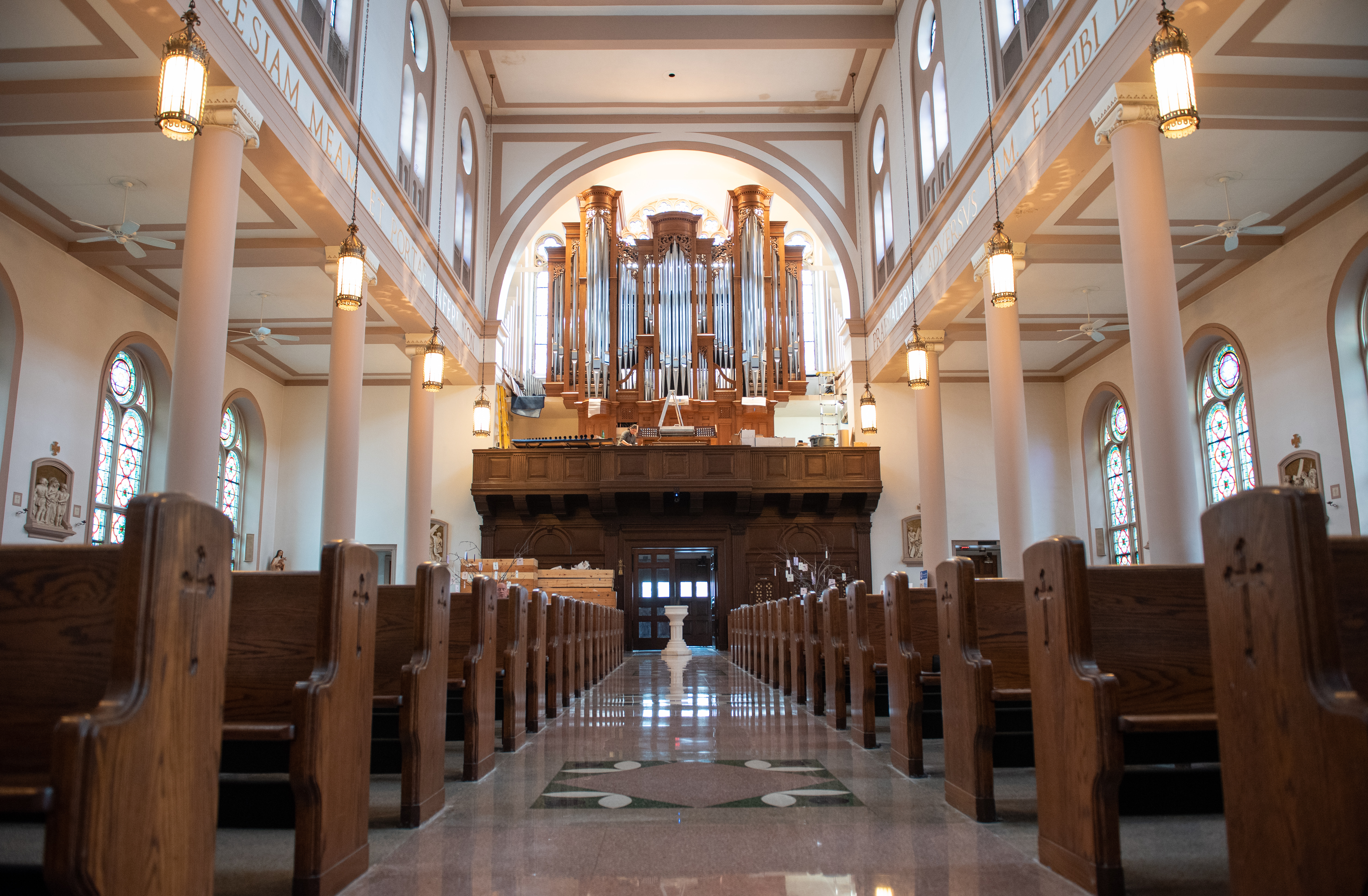During the Easter Vigil this year, the parishioners of St. Peter’s Church on Capitol Hill will not only be able to see flickering candlelight, smell incense, and feel holy water on their skin – they will also hear the notes of their parish’s newly installed organ for the first time. As the liturgy moves from dark to light, and from the silence of Lent into the joy of Easter, the organ will sound for the first time during the “Gloria,” and then be played again when the congregation sings “hallelujah.”
“I can’t think of anything better than that pair of items for its matron voyage,” said Kevin O’Brien, the parish’s music director.
Their previous organ had been in the church since about 1940, when it was installed after a fire had burnt most of the building to the ground. In 2001, the earthquake that hit Washington caused a large portion of the plaster wall to come loose and crash into the organ, infiltrating the winding system, which would cause the instrument to rot from the inside out. After considering many different options, they decided that starting with a new organ was the best solution.
The new pipe organ weighs about 19,000 pounds and contains about 5,000 moving parts, including 2,599 pipes. It arrived at the parish in February and took more than a month to install.

As he sat in the sanctuary of St. Peter’s on one of the first days of the organ installation, O’Brien explained the many intricacies involved in playing the instrument, such as the different combinations between the organ’s 61 keys and 47 stops that are needed to produce notes in higher or lower pitches. The stops, which are the knobs located on either side of the organ’s keys, control the airflow going into different sets of pipes. The pipes that make up St. Peter’s new organ range in size from roughly the height of a pencil to 18 feet tall.
The new organ, built by Noack Organ Company, was first assembled in their shop over about a year’s time. It was then disassembled, put on an 18-wheel truck and delivered to St. Peter’s. When it first arrived, the parts were all scattered throughout the sanctuary of the Church, and O’Brien invited students from St. Peter’s School to come and see the pieces.

The organ should be “earthquake proof” thanks to its positioning between two brick portions of the church building, which they had originally intended to remove. When they found out that they were necessary for the structure of the building, Didier Grassin, the president of the Noack Organ Company, redesigned the organ to fit around them.
In his role as music director and organ player, O’Brien sees it as his job to lead the congregation into an encounter with Christ in the Mass, which he said is both “wholly about being a musician and wholly about being a minister to the Church.”
O’Brien, who earned his Doctor of Musical Arts from The Catholic University of America in Washington, D.C., has been playing the organ since he was about 14. He was an altar server at his parish and had been taking piano lessons, so when there was a need for someone to play the organ, he stepped in. Now, “I could scarcely conceptualize my life without it,” he said.

“I had a love for liturgy before I came to know music, but they grew at the same time,” said O’Brien. And just as he grew up playing the organ, he said the organ “grew up in the Church,” because it is particularly well suited to large rooms like church sanctuaries.
“We want people to be in awe of its power, and also in awe of the beauty of it,” he said, adding that it is important that people standing in each part of the church feel like the music is reaching them.
O’Brien said the Church has learned a lot about how to build organs and about the liturgical needs of the community since the time the old organ in St. Peter’s was built. Since the Second Vatican Council encouraged the full conscious act of participation from the congregation, a different type of organ is needed to play alongside the congregation, he said.
In addition to having an organ that would produce beautiful music, O’Brien emphasized the importance of “having an instrument that makes you feel like you can open up your lungs and make you feel supported; not self-conscious.”
“Feeling supported is the first step to making you feel you can open up,” he said, adding that the organ’s role is as a “musical parent” that helps the congregation “find its voice.”
The new organ is a mechanical-action organ, which is an older organ design that O’Brien said is more reliable and functions “less like a machine that you handle and more like an instrument you draw out.” The key that the organ player presses is directly connected to the organ’s pipes through a tracker that runs underneath the floor. O’Brien said having a mechanical-action organ allows him to “get involved in the music in a more visceral, organic way.”
“It allows the instrument to feel more human, like it is connected to the breath of the singing of the congregation,” he said.

Father Gary Studniewski, the pastor of St. Peter’s, said having music is “essential to the liturgy.”
“It is one of the most beautiful ways we have of getting out of ourselves and lifting our hearts to something beyond ourselves, and we are doing it as a collective body,” he said. “Singing is generating prayer. We don’t listen to songs as prayer; we generate prayers with the songs we sing. There is no instrument like the pipe organ to support the congregation in lifting their hearts and minds to God.”
Both O’Brien and Father Studniewski are excited for the outreach that the organ is going to allow them to do to the wider community through hosting concerts. By inviting people who may not necessarily otherwise come to their church, they hope to introduce them to their parish community.
Heeding Pope Francis’s call to evangelize through the arts, the St. Peter’s has already been hosting a concert series called ”Sacred Music from the Hill,” which O’Brien said lives out the parish’s mission “to be a tangible manifestation of Christ present on Capitol Hill.”
The organ is a gift from current parishioners to future generations of parishioners who will enjoy the music, just as current parishioners are able to enjoy the church’s stained glass windows because of the generosity of past parishioners, said O’Brien.
“I am excited for what it will do for our congregational signing, that is for sure,” said Father Studniewski. “It is going to lend itself so beautifully, not only because of its range and all the different kinds of beautiful sounds, but there is nothing like a pipe organ to lead congregational singing. That music is coming through pipes and that is what the human voice is.”









